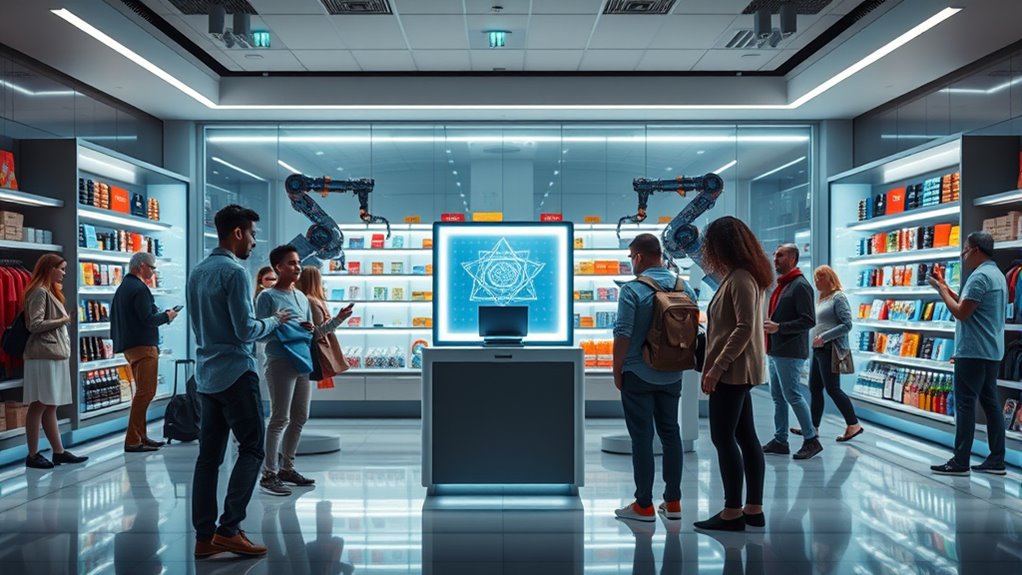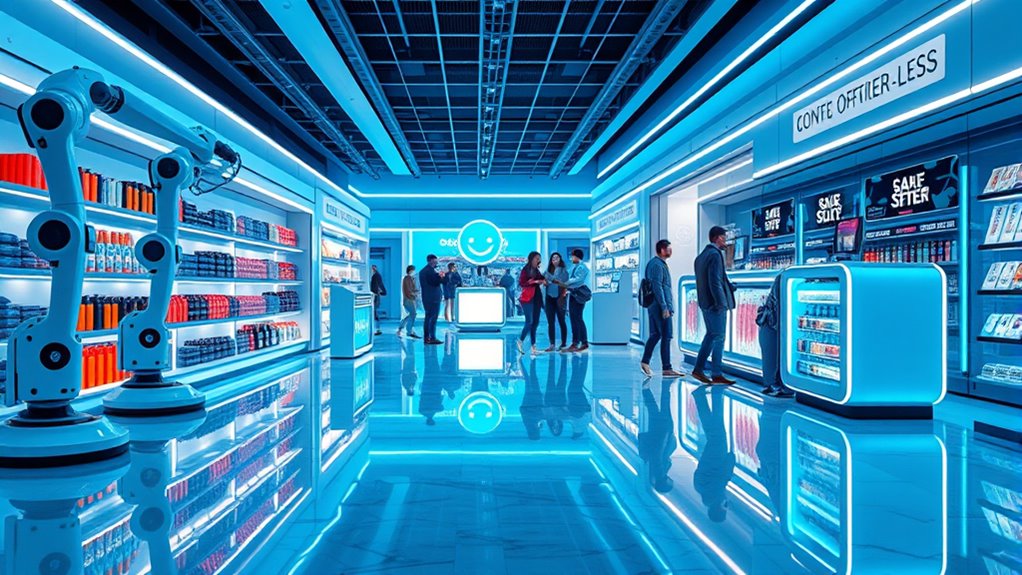When AI runs the store, the real winners are the retailers who harness its power to boost revenue, cut costs, and gain a competitive edge. With AI-driven personalization, recommendations, and automation, they increase sales and improve operational efficiency. Customers benefit too through better experiences. But ultimately, those who use AI effectively will see the most rewards—if you keep exploring, you’ll discover how to capitalize on this technology even more.
Key Takeaways
- Retailers benefit through increased revenue, improved margins, and operational cost savings enabled by AI-driven efficiencies and insights.
- Customers enjoy personalized experiences, tailored offers, and smoother shopping journeys, boosting satisfaction and loyalty.
- Investors and top retailers who effectively leverage AI gain competitive advantages, faster growth, and market share dominance.
- AI technology fosters innovation, enhances security, and drives sector-wide advancements, creating long-term ecosystem benefits.
- Successful AI adoption results in higher profitability and strategic positioning, rewarding those who implement and optimize AI solutions.

Have you ever wondered who truly benefits from the rise of AI in retail? The answer isn’t just the companies investing in the technology; it’s a broader ecosystem that includes both retailers and their customers. When AI is integrated effectively, retailers see at least a 20% boost in revenue on average, with some experiencing increases as high as 300% thanks to advanced recommendation engines. Personalized shopping experiences powered by AI can lift revenue by up to 40%, creating a more engaging and satisfying journey for shoppers. Chatbots, for example, can increase sales by 67%, helping customers find what they need quickly and effortlessly. As a result, 69% of retailers using AI report higher annual revenue, with many enjoying gains above 5% or even 15%. This growth benefits retailers directly, but it also flows down to consumers, who enjoy more tailored, convenient shopping experiences.
Market growth continues to accelerate, fueling further adoption and innovation across sectors. Additionally, the integration of AI security measures helps protect both retailers and consumers from cyber threats, ensuring that the benefits are sustainable and trustworthy.
AI doesn’t just grow revenue; it also cuts costs. Retailers using AI average an 8% reduction in operational expenses, primarily through optimized inventory management and automation. Nearly three-quarters of AI-enabled retailers report lower operating costs, with some saving over 15%. These savings often translate into better margins and competitive pricing, ultimately benefiting shoppers. For the customer, AI enhances service levels by 65%, reduces inventory by 20%, and boosts retention rates by 10%–15%. Customers feel the impact through higher satisfaction, more personalized offers, and a smoother shopping experience.
On a strategic level, AI grants retailers a significant advantage in market share and margins. Leading players investing in AI and automation are expanding faster and consolidating market power, with valuation spreads widening between top performers and others. This means that successful AI adoption isn’t just about immediate gains; it’s about long-term dominance and profitability. While adoption remains uneven—only 42% of retailers have fully embraced AI—the ones who do benefit from increased efficiency, smarter decision-making, and new revenue streams like retail media. Ultimately, AI runs the store, but the true winners are the retailers who leverage it wisely and the customers who enjoy better prices, personalized experiences, and improved service.
Frequently Asked Questions
How Does AI Determine Customer Preferences?
AI determines your preferences by analyzing your past behaviors, such as purchase history, browsing patterns, and social media activity. It continuously updates its models with new data to refine predictions. By identifying subtle patterns and trends, AI can forecast what you’re likely to want or need next. This personalized approach helps businesses recommend products, tailor marketing messages, and enhance your overall shopping experience based on your unique preferences.
What Ethical Concerns Arise From Ai-Managed Stores?
You might find it unsettling, but AI-managed stores raise ethical concerns like invasions of privacy, especially with extensive data collection and surveillance. You could worry about algorithmic bias skewing fairness, or how transparent the system really is. There’s also the risk of misleading marketing with AI-generated content. Ensuring informed consent, protecting personal data, and maintaining transparency are crucial to building your trust and safeguarding your rights in these automated environments.
Can AI Replace Human Employees Entirely?
AI can fully replace human employees in certain routine jobs, like clerical work or manufacturing tasks, but it can’t handle roles requiring emotional intelligence, complex judgment, or creativity. You might see some jobs disappear, but many will shift toward collaboration with AI. To stay relevant, you should focus on upskilling in areas where human qualities still hold value, as complete automation isn’t feasible across all sectors yet.
How Are AI Profits Distributed Among Stakeholders?
You see, AI profits are shared among various stakeholders. Retailers benefit through higher margins, cost savings, and new revenue streams from customer data insights. AI technology providers earn from licensing, customization, and ongoing support. Your workforce gains by upskilling and collaborating with AI, boosting efficiency. Ultimately, the distribution depends on strategic investments in data ownership, ethical deployment, and how well stakeholders align to maximize AI’s value across the supply chain.
What Safeguards Prevent AI From Making Biased Decisions?
You might think AI’s decision-making is a free-for-all, but nope, safeguards are in place. Data governance keeps bad data out, while responsible AI tools spot biases before they cause trouble. Continuous audits, fairness metrics, and multidisciplinary teams act like watchdogs, catching and correcting unfair decisions. These layers of oversight make certain your AI doesn’t accidentally become the digital villain, making fair choices instead of biased blunders.
Conclusion
As AI transforms retail, you might wonder who truly profits. Remarkably, studies show that only about 10% of savings from automation reach workers, while the rest benefit owners and shareholders. This highlights a growing gap between technological advancement and fair distribution. As you witness AI’s rise, remember that ensuring equitable rewards means rethinking how benefits are shared. Ultimately, fostering a balanced approach can create a future where everyone gains from innovation, not just a select few.










